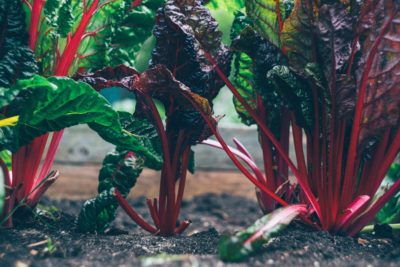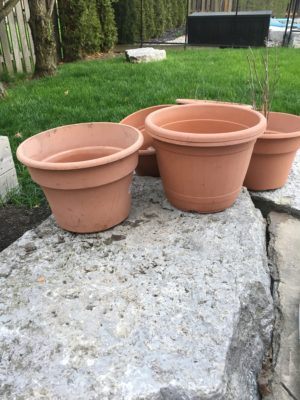16 May The 411 on Growing a Vegetable Garden
 The May long weekend is the unofficial start to Ontario’s gardening season! If you have been thinking about growing some vegetables and herbs this year keep reading to find out how to get started!
The May long weekend is the unofficial start to Ontario’s gardening season! If you have been thinking about growing some vegetables and herbs this year keep reading to find out how to get started!
There are so many amazing benefits of growing a vegetable garden such as saving money, getting kids to work together, appreciating nature and learning new skills. Having kids help with planting, watering and especially harvesting vegetables creates a connection with food that you can’t get from a trip to the grocery store.
Studies have shown that growing a vegetable garden promotes healthy eating habits in children. The best part is that growing a vegetable garden is not hard. If you are new to growing a vegetable garden you can always start small by using a container. Container gardening is a perfect option when you don’t have the proper land, light or soil to grow vegetables in the ground. The key is to grow vegetables that your family enjoys. Each year, I ask my kids to choose vegetables they want to grow; our top choices include cucumbers, carrots, and peppers. Here are the best vegetables to grow in a container:
- Tomatoes
- Lettuce
- Spinach
- Radishes
- Peppers and chilies
Make sure your container is large enough and has a hole at the bottom for drainage. Stay away from black pots since they absorb the most heat. Terracotta pots and five-gallon buckets are best to use.
1. Make sure you choose your container site carefully ensuring you are getting at least 6 hours of sunlight a day
2. Use organic potting soil for container gardening
3. Make sure to water frequently and never let the soil dry out
4. Fertilize every few weeks
Raised Beds
Raised garden beds (AKA garden boxes) are great for growing small plots of vegetables. A raised bed prevents weeds from growing in your garden soil, prevents soil compaction, and provides good drainage, and serves as a barrier to pests such as slugs and snails. The sides of the beds keep your valuable garden soil from eroding or washing away during heavy rains. You can buy raised bed pre-assembled or make it yourself. My husband made our raised bed a few years ago using cedar wood; cedar is the best wood to use for garden beds since it is naturally rot resistant.
There are 3 things that every plant requires:
Sunlight: Getting adequate sunlight is key. Plants need at least 6 hours of direct sunlight. There are many factors that affect the sunlight such as the orientation of your property, high fences, and trees. However, leafy greens do pretty well in the shade.
Soil: You need really good soil to yield good plants. You can improve your soil by adding plenty of compost and well-rotted manure into your soil. Most vegetables do best in moist, well-drained soil that is rich in organic matter, such as compost or peat moss. It’s best to use organic soil that hasn’t been treated with any chemicals since these chemicals can be leached into your harvest. If you are converting a flowerbed to a vegetable garden make sure your soil is free of synthetic fertilizers and pesticides since you will be eating the vegetables.
Water: All plants need water, and some veggies may need more. The key is to water consistently make sure the soil is damp to a depth of at least 6 inches.
Seeds or seedlings?
Seeds are inexpensive compared to the cost of seedlings (transplants), but some vegetables are difficult to start from seeds, and others take a long time to mature. Planting from seeds may not be practical for long-season plants in regions with short growing seasons. Do you best to get your plants in the ground as early as possible to give them time to acclimate to the warming weather and to provide them with the longest growing season possible.
 It’s also important to plan out your vegetable garden. For example, 1 square foot of a vegetable garden can produce 4 heads of lettuce, one pepper plant or 16 radishes. My raised bed is 4’x8’ keeping enough spacing between your veggies is also really important. Make sure to read the instructions for the vegetables you are growing. You don’t want to overcrowd your garden, which can impact the health of the plants and yield. Take a look at this guide to determine the spacing you need.
It’s also important to plan out your vegetable garden. For example, 1 square foot of a vegetable garden can produce 4 heads of lettuce, one pepper plant or 16 radishes. My raised bed is 4’x8’ keeping enough spacing between your veggies is also really important. Make sure to read the instructions for the vegetables you are growing. You don’t want to overcrowd your garden, which can impact the health of the plants and yield. Take a look at this guide to determine the spacing you need.
I typically grow 5 – 6 veggies in my raised bed and grow herbs and tomatoes in container pots. I usually use seedlings since the season is short in Ontario. I do use seeds for growing carrots and radishes since they have roots, which makes it hard to transport.
What vegetables and herbs are you planning to grow this season?





Sorry, the comment form is closed at this time.